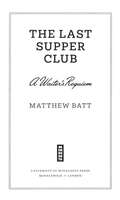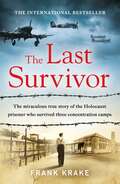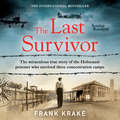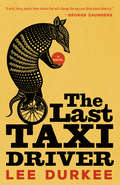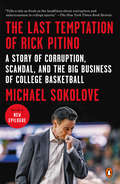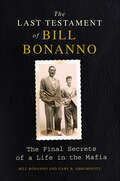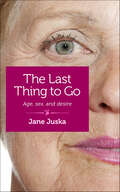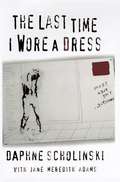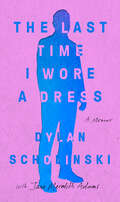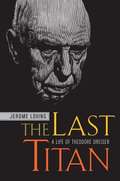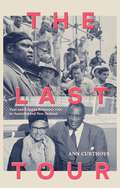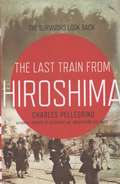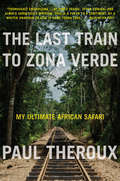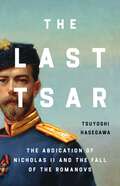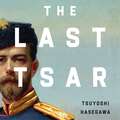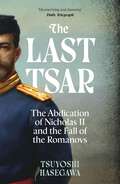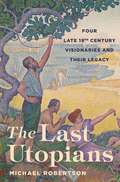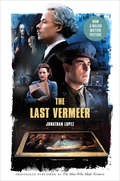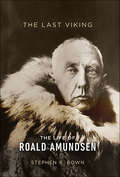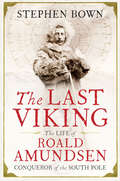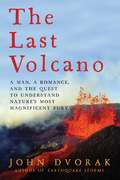- Table View
- List View
The Last Supper Club: A Waiter's Requiem
by Matthew BattA witty and humble tribute to the sometimes profane, sometimes profound world of waiting tables During a year on sabbatical from his university position, Matthew Batt realized he needed money—fast—and it just so happened that one of the biggest breweries in the Midwest was launching a restaurant and looking to hire. So it was that the forty-something tenured professor found himself waiting tables at a high-end restaurant situated in a Minneapolis brewery. And loving it. Telling the story of Batt’s early work in restaurants, from a red sauce joint possibly run by the mob to an ill-conceived fusion concept eatery, The Last Supper Club then details his experiences at the fine dining restaurant, a job that continued well past his sabbatical—that lasted, in fact, right up to the restaurant’s sudden and unceremonious closing three years later, shortly after it was named one of the best restaurants in the country by Food & Wine. Batt’s memoir conveys the challenge—and the satisfaction—of meeting the demands of a frenzied kitchen and an equally expectant crowd. Through training mishaps, disastrous encounters with confused diners, struggles to keep pace with far more experienced coworkers, mandatory memorizations of laundry lists of obscure ingredients, and the stress of balancing responsibilities at home and at work, The Last Supper Club reveals the ups and downs of a waiter’s workday and offers an insightful perspective on what makes a job good, bad, or great. For Batt, this job turns out to be considerably more fun, and possibly more rewarding, than his academic career, and his insider’s view of waiting tables extols the significance of our food and the places where we gather to enjoy it—or serve it. Told with sharp humor, humility, and a keen sense of what matters, The Last Supper Club is an ode to life in a high-pressure restaurant, the relationships that get you to the night’s close, and finding yourself through—or perhaps because of—the chaos of it all.
The Last Supper Club: A Waiter's Requiem
by Matthew BattA witty and humble tribute to the sometimes profane, sometimes profound world of waiting tables During a year on sabbatical from his university position, Matthew Batt realized he needed money—fast—and it just so happened that one of the biggest breweries in the Midwest was launching a restaurant and looking to hire. So it was that the forty-something tenured professor found himself waiting tables at a high-end restaurant situated in a Minneapolis brewery. And loving it. Telling the story of Batt&’s early work in restaurants, from a red sauce joint possibly run by the mob to an ill-conceived fusion concept eatery, The Last Supper Club then details his experiences at the fine dining restaurant, a job that continued well past his sabbatical—that lasted, in fact, right up to the restaurant&’s sudden and unceremonious closing three years later, shortly after it was named one of the best restaurants in the country by Food & Wine. Batt&’s memoir conveys the challenge—and the satisfaction—of meeting the demands of a frenzied kitchen and an equally expectant crowd. Through training mishaps, disastrous encounters with confused diners, struggles to keep pace with far more experienced coworkers, mandatory memorizations of laundry lists of obscure ingredients, and the stress of balancing responsibilities at home and at work, The Last Supper Club reveals the ups and downs of a waiter&’s workday and offers an insightful perspective on what makes a job good, bad, or great. For Batt, this job turns out to be considerably more fun, and possibly more rewarding, than his academic career, and his insider&’s view of waiting tables extols the significance of our food and the places where we gather to enjoy it—or serve it. Told with sharp humor, humility, and a keen sense of what matters, The Last Supper Club is an ode to life in a high-pressure restaurant, the relationships that get you to the night&’s close, and finding yourself through—or perhaps because of—the chaos of it all.
The Last Survivor
by Frank Krake'This is an extraordinary biography. A gripping narrative that opens as derring-do wartime escape drama rapidly turns into a horror story about man's inhumanity to man...Important and unforgettable' Jonathan Dimbleby, bestselling authorPerfect for readers of Last Stop Auschwitz, The Volunteer and The Tattooist of Auschwitz.---- The awe-inspiring and gripping true story of the young man who survived not one, but three concentration camps, only - in the final days of the war - to be bombed while aboard a Nazi prison boat. Stowed away on top of a train, twenty-year-old Wim Aloserij escapes the obligatory work camps in Nazi-ruled Germany in 1943. The young man from Amsterdam then goes into hiding on a farm - sleeping for months in a wooden chest hidden underground. But it's not to last.In the cover of night, Wim is captured during a raid and transported to the infamous Gestapo prison in Amsterdam. There, his life changes forever as he is thrown into the nightmare of the Holocaust and transported to Camp Amersfoort - the first of three concentration camps he must endure. Drawing on the lessons he learned as a child as the victim of an alcoholic and abusive father, Wim is forced to adapt quickly and urgently to his hellish surroundings. However, it is with the end of the war in sight, that Wim must draw on every last strength he has when he finds himself caught in the very centre of Allied-Nazi crossfire. At the age of 94, Wim finally felt ready to tell his incredible story, which he kept secret for most of his life. A true story of bravery, courage and resilience, The Last Survivor is a compelling, life-affirming read that will make you gasp but also leave you amazed by one young man's determination - against the odds - to survive.
The Last Survivor
by Frank KrakeThe awe-inspiring and gripping true story of the young man who survived not one, but three concentration camps, only - in the final days of the war - to be bombed while aboard a Nazi prison boat. Stowed away on top of a train, twenty-year-old Wim Aloserij escapes the obligatory work camps in Nazi-ruled Germany in 1943. The young man from Amsterdam then goes into hiding on a farm - sleeping for months in a wooden chest hidden underground. But it's not to last. <p><p>In the cover of night, Wim is captured during a raid and transported to the infamous Gestapo prison in Amsterdam. There, his life changes forever as he is thrown into the nightmare of the Holocaust and transported to Camp Amersfoort - the first of three concentration camps he must endure. <p><p>Drawing on the lessons he learned as a child as the victim of an alcoholic and abusive father, Wim is forced to adapt quickly and urgently to his hellish surroundings. However, it is with the end of the war in sight, that Wim must draw on every last strength he has when he finds himself caught in the very centre of Allied-Nazi crossfire. <p><p>At the age of 94, Wim finally felt ready to tell his incredible story, which he kept secret for most of his life. A true story of bravery, courage and resilience, The Last Survivor is a compelling, life-affirming read that will make you gasp but also leave you amazed by one young man's determination - against the odds - to survive.
The Last Taxi Driver
by Lee Durkee"A wild, funny, poetic fever-dream that will change the way you think about America." --George Saunders Written by a former cabbie, The Last Taxi Driver is equal parts Bukowski and Portis, and an homage to a dying American industry. Written by a former cabbie, The Last Taxi Driver is a darkly comic novel about a middle-aged hackie’s daylong descent into madness, heartbreak, and murder. Lou—a lapsed novelist and UFO aficionado—drives 70-hour weeks for a ramshackle taxi company that operates on the outskirts of a north Mississippi college town among the trailer parks and housing projects. With Uber moving into town and his way of life fast vanishing, his girlfriend moving out on him, and his archenemy-dispatcher suddenly returning to the state on the lam, Lou must keep driving his way through a bedlam shift even when that means aiding and abetting the host of criminal misfits haunting the back seat of his Town Car. Shedding nuts and bolts at every turn, The Last Taxi Driver careens through the highways and back roads, from Mississippi to Memphis and back, as Lou becomes increasingly somnambulant and his fares increasingly eccentric. Equal parts Bukowski and Portis, Durkee’s novel is an homage to a dying American industry.
The Last Temptation of Rick Pitino: A Story of Corruption, Scandal, and the Big Business of College Basketball
by Michael SokoloveFrom acclaimed New York Times Magazine author Michael Sokolove, the astonishing inside story of the epic corruption scandal that has rocked the NCAA and exposed the rot and hypocrisy at the heart of big-time college sports.At a lavish annual event in late August 2017, the University of Louisville athletic director, who made more than $5 million in compensation in 2016, announced an extension of his school's sponsorship deal with Adidas: $160 million for another 10 years. The invitees were city's gentry - horse breeders, bourbon distillers, partners at big law firms, the state's governor, Matt Bevin, and its most powerful politician, Senate Majority Leader Mitch McConnell. One month later, the FBI revealed that it had reached the endgame of a sprawling investigation of large-scale corruption involving Adidas, Louisville and a host of other colleges, in which large payments were laundered from Adidas through a network of coaches and fixers to athletes and their families to induce them to go to Adidas-branded college programs. In short order, Hall of Fame basketball coach Rick Pitino (salary: $8 million) and athletic director Tom Jurich were fired, and fear and trembling swept through the world of bigtime college athletics. Because there is another shoe, as it were, and it will fall.In THE LAST TEMPTATION OF RICK PITINO, Michael Sokolove lifts the rug on the Louisville scandal and places it in the context of the much wider problem, the farce of amateurism in bigtime college sports. In a world in which even assistant coaches can make high-six and seven-figure salaries, as long as they keep the "elite" athletes coming in, shoe deals can reach into the nine figures, and everyone is getting rich but the players, can it be surprising that unscrupulous parties would pay athletes, creating in effect a black market in young men, a veritable underground railroad of talent? But a few bad apples are one thing. In THE LAST TEMPTATION OF RICK PITINO, Michael Sokolove shows an elaborate, systematic machine, involving hundreds of thousands of dollars in illicit payments and connecting at least one of the largest apparel companies in the world with schools across the country. The Louisville-Adidas scandal has revealed a web of conspiracy whose scope has shaken big-time college sports to its core, delivering a devastating blow to the fantasy of amateurism, of "scholar athletes." A Shakespearean drama of greed and desperation involving some of the biggest characters in the arena of sports, THE LAST TEMPTATION OF RICK PITINO will be the definitive chronicle of this scandal and its broader echoes.
The Last Testament of Bill Bonanno: The Final Secrets of a Life in the Mafia
by Bill Bonanno Gary B. AbromovitzThe final, tell-all memoir from the legendary mafia consigliere and son of infamous crime boss Joe Bonnano.Born into a powerful mob family, Salvatore “Bill” Bonanno was privy to a criminal underworld that wielded immense power in America for decades—a world ruled by loyalty, secrecy, and survival at any cost: the Mafia.The son of Joe Bonanno—the Godfather-like head of one of the original five New York Crime Families—Bill Bonanno came of age at the height of Mafia power. In this fascinating final testament, he ushers readers into that cloistered world, from its origins in medieval Sicilian and Italian history to its rise, tumultuous peak, and precipitous fall in America. Complete with rare unpublished photographs of candid moments, major players, rituals, and ceremonies, The Last Testament of Bill Bonanno is the ultimate insider’s final word on one of the most secretive and misunderstood phenomena of our time.
The Last Thing to Go: Age, Sex, and Desire
by June JuskaJoan Didion and Nora Ephron have both written, by turns grimly and hilariously, about the indignities of getting older. Now comes Jane Juska, laying bare (literally) everything no one has yet said about life in the later years. With her characteristic wit, unsparing eye for detail, and famously frank opinions on gender issues, Juska, author of the best-selling memoir A Round-Heeled Woman, talks sex, the ups and downs of body parts well below the neck, and the indomitable human need for connection, whatever a woman’s age.
The Last Time I Wore a Dress
by Daphne ScholinskiAt the age of fifteen, Daphne Scholinski was put in a mental hospital for what her psychiatrist called? failure to identity as a sexual female.' The hospital gave her a diagnosis that was brand-new to the medical books: Gender Identity Disorder. The years that should have been Daphne's typical high school experience instead consisted of periods of seclusion and physical restraint, frequent does of sedatives, and the close company of people who were truly crazy. It’s hard to believe that doctors, circa 1981, described Daphne's treatment goals as becoming more obsessive about boys, learning about makeup, dressing more like a girl, curling and styling hair, and spending quality time learning about girl things with peers. Even now, after a decade and a half of our culture's coming to grips with homosexuality, approximately fifty thousand teenagers are institutionalized in the U.S. each year for being too sissy or too much of a tomboy. Though the facts are truly frightening, Jane Meredith Adams has captured Daphne's fresh, funny, triumphant voice so vividly that The Last Time I Wore a Dress is impossible to put down. The result is a book is reminiscent of The Catcher in the Rye and One Flew Over the Cuckoo's Nest as well as an expose of a shameful medical sham that has destroyed countless childhoods.
The Last Time I Wore a Dress
by Dylan ScholinskiUPDATED WITH A NEW EPILOGUE At fifteen years old, Daphne Scholinski was committed to a mental institution and awarded the dubious diagnosis of Gender Identity Disorder. For three years and more than a million dollars of insurance, the problem was &“treated&”—with makeup lessons and instructions in how to walk like a girl. With a new epilogue by Scholinski, whose name is now Dylan and who identifies as nonbinary, this revised paperback edition of The Last Time I Wore a Dress looks back at those experiences and their life since. It chronicles the journey of coming into oneself and gaining a nuanced, freeing understanding of being born transgender. This memoir tells Dylan Scholinski&’s remarkable story in an honest, unforgettable voice that&’s both heartbreaking and hopeful.
The Last Titan: A Life of Theodore Dreiser
by Jerome LovingA standard biography of one of America's best novelists, Theodore Dreiser, this book paints a full portrait of a writer who boldly swept away Victorian timidity to open the twentieth century in American literature.
The Last Torpedo Flyers
by Mark Ryan Arthur AldridgeImagine you are an RAF torpedo pilot in World War Two, sent on missions so dangerous that you're later likened to the Kamikaze. Suicide wasn't a recognised part of the objective for British airmen, yet some pilots felt they had accepted certain death just by climbing into their cockpits. There were times in 1942 when Arthur Aldridge felt like this. At the age of 19, this courageous young man had quit his studies at Oxford to volunteer for the RAF. He flew his Bristol Beaufort like there was no tomorrow - a realistic assumption, after seeing his best friend die in flames at the end of 1941. Aldridge was awarded a DFC (Distinguished Flying Cross) for his bravery on the same strike on a German cargo ship during which he lost a wing tip by flying too close to the deck. He was equally lucky to survive his squadron's chaotic torpedo attack on the giants of Hitler's maritime fleet during the notorious Channel Dash, which saw 40 RAF planes shot down. As 1942 wore on, and the stress became intolerable, Aldridge and his Cockney gunner Bill Carroll held their nerve, and 'Arty' was awarded a Bar to his DFC for sinking two enemy ships off Malta and rescuing a fellow pilot while wounded, as his own Beaufort took four shells. Malta was saved by the skin of its teeth, Rommel denied vital supplies in North Africa, and the course of the war was turned. Aldridge was still only 21 years old. Now both 91, but firm friends as ever, Aldridge and Carroll are two of the last torpedo airmen who deserve their place in history alongside our heroic Spitfire pilots. Their story vividly captures the comradeship that existed between men pushed by war to their very limit.
The Last Tour: Paul and Eslanda Robeson's Visit to Australia and New Zealand in 1960
by Ann CurthoysPaul Robeson was once the most famous African American in the world. Not only was he a renowned singer and actor with a stunning bass baritone voice, revered throughout the world, he was also a former professional athlete, lawyer and civil rights activist. To the delight of his many fans, he and his wife, Eslanda—a notable civil rights activist, author, United Nations journalist and anthropologist—were finally able to tour Australia and New Zealand. First mooted in the 1930s, it had been delayed by war and then the Cold War, when Paul&’s outspoken support for the Soviet Union and against his country&’s race relations had led the US government to deny him a passport until 1958. Now, in 1960, the tour occurred at a time when the world was at the tipping point between the Cold War 1950s and the turbulent 1960s. The Robesons&’ tour encompassed concerts—the first one ever at the Sydney Opera House, which was still under construction—talks to unionists, fans, women&’s organisations, communists, and peace activists. It involved active engagement with Indigenous peoples and their struggles in both countries. Through their engagement with a wide range of people we see life on the far Left, the emergence of new forms of Aboriginal and Maori protest, and the reception and influence of African American entertainers in Australia and New Zealand. By bringing Eslanda&’s work as a writer and journalist to the fore, historian Ann Curthoys sheds light on the intersections of race, gender and women&’s political activism. Based on extensive new documentary and oral history research, The Last Tour explores why Paul and Eslanda Robeson&’s trip was such a success and how it exerted a profound influence both at the time and over future generations. &‘No man I&’ve ever met has so impressed me with his personal greatness. He&’s so simple and unaffected in his manner, so dignified … it&’s the man himself, I think, who demonstrates the greatness of the human spirit.&’ Katharine Susannah Prichard on Paul Robeson
The Last Train from Hiroshima: The Survivors Look Back
by Charles PellegrinoDrawing on the voices of atomic bomb survivors and the new science of forensic archaeology, Charles Pellegrino describes the events and aftermath of two days in August when nuclear devices detonated over Japan changed life on earth forever. At the narrative's core are the eyewitness accounts of the people who experienced the effects of the atomic explosions firsthand. Thirty people are known to have fled Hiroshima for the imagined safety of Nagasaki--where they arrived just in time to survive yet another atomic bomb. Tsutomu Yamaguchi, who is still alive, is the only person known to have survived the full effects of the blast at Ground Zero both times. The second time, the blast effects were diverted around the stairwell of a building in which he had been standing, placing him and the small group of people standing with him in a shock cocoon, while the entire office building disappeared around them. Almost everything we know about the bombing turns out to be wrong. For all its fury the Hiroshima bomb had been compromised during a preflight test. Only hours before Enola Gay took off, on August 6, physicist Luis Alvarez juiced up the weakened bomb with three plugs of polonium and beryllium (the nuclear equivalent of inserting nitrous oxide into a race car's engine). A stunning "you are there" time capsule, The Last Train from Hiroshima is enriched by the author's scientific authority and close relationship with the bombs' survivors, making his account the most gripping ever written.
The Last Train to Zona Verde: My Ultimate African Safari
by Paul TherouxThe acclaimed author of Dark Star Safari journeys across western Africa in this &“thoroughly engrossing [and] at times tragic&” travelogue (Washington Post).Paul Theroux&’s best-selling Dark Star Safari chronicled his epic overland voyage from Cairo to Cape Town, providing an insider&’s look at modern Africa. Now, with The Last Train to Zona Verde, he returns to discover how both he and Africa have changed in the ensuing years. Traveling alone, Theroux sets out from Cape Town, going north through South Africa, Namibia, then into Angola, encountering a world increasingly removed from tourists&’ itineraries and the hopes of postcolonial independence movements. After covering nearly 2,500 arduous miles, Theroux cuts short his journey, a decision he chronicles with unsparing honesty in a chapter titled &“What Am I Doing Here?&” Vivid, witty, and beautifully evocative, The Last Train to Zona Verde is a fitting final African adventure from the writer whose gimlet eye and effortless prose have brought the world to generations of readers. &“If this book is proof, age has not slowed Theroux or encouraged him to rest on his achievements . . . Gutsy, alert to Africa's struggles, its injustices and history.&” — San Francisco Chronicle
The Last Tsar: The Abdication of Nicholas II and the Fall of the Romanovs
by Tsuyoshi Hasegawa&“Elegantly written and magisterially researched&” (Robert Service, author of A History of Modern Russia), the definitive story behind the self-destruction of the autocratic Romanov dynasty, by the world&’s foremost expert When Tsar Nicholas II fell from power in 1917, Imperial Russia faced a series of overlapping crises, from war to social unrest. Though Nicholas&’s life is often described as tragic, it was not fate that doomed the Romanovs—it was poor leadership and a blinkered faith in autocracy. Based on a trove of new archival discoveries, The Last Tsar narrates how Nicholas&’s resistance to reform doomed the monarchy. Encompassing the captivating personalities of the era, it untangles the struggles between the increasingly isolated Nicholas and Alexandra and the factions of scheming nobles, ruthless legislators, and pragmatic generals who sought to stabilize the restive Russian empire either with the Tsar or without him. By rejecting compromise, Nicholas undermined his supporters at crucial moments. His blunders cleared the way for all-out civil war and the eventual rise of the Soviet Union. Definitive and engrossing, The Last Tsar uncovers how Nicholas II stumbled into revolution, taking his family, the Romanov dynasty, and the whole Russian Empire down with him.
The Last Tsar: The Abdication of Nicholas II and the Fall of the Romanovs
by Tsuyoshi HasegawaA HISTORY TODAY BOOK OF THE YEAR'Certain to become the definitive work' DOUGLAS SMITH'Elegantly written and magisterially researched' ROBERT SERVICE'Masterful . . . a chilling lesson' VLADISLAV ZUBOKThe definitive story behind the self-destruction of the autocratic Romanov dynasty, by the world's foremost expert.When Tsar Nicholas II fell from power in 1917, Imperial Russia faced a series of overlapping crises, from war to social unrest. Though Nicholas's life is often described as tragic, it was not fate that doomed the Romanovs - it was poor leadership and a blinkered faith in autocracy.Based on a trove of new archival discoveries, The Last Tsar narrates how Nicholas's resistance to reform doomed the monarchy. Encompassing the captivating personalities of the era, it untangles the struggles between the increasingly isolated Nicholas and Alexandra and the factions of scheming nobles, ruthless legislators, and pragmatic generals who sought to stabilize the restive Russian empire either with the Tsar or without him. By rejecting compromise, Nicholas undermined his supporters at crucial moments. His blunders cleared the way for all-out civil war and the eventual rise of the Soviet Union.Definitive and engrossing, The Last Tsar uncovers how Nicholas II stumbled into revolution, taking his family, the Romanov dynasty, and the whole Russian Empire down with him.
The Last Tsar: The Abdication of Nicholas II and the Fall of the Romanovs
by Tsuyoshi HasegawaA HISTORY TODAY BOOK OF THE YEAR'Certain to become the definitive work' DOUGLAS SMITH'Elegantly written and magisterially researched' ROBERT SERVICE'Masterful . . . a chilling lesson' VLADISLAV ZUBOKThe definitive story behind the self-destruction of the autocratic Romanov dynasty, by the world's foremost expert.When Tsar Nicholas II fell from power in 1917, Imperial Russia faced a series of overlapping crises, from war to social unrest. Though Nicholas's life is often described as tragic, it was not fate that doomed the Romanovs - it was poor leadership and a blinkered faith in autocracy.Based on a trove of new archival discoveries, The Last Tsar narrates how Nicholas's resistance to reform doomed the monarchy. Encompassing the captivating personalities of the era, it untangles the struggles between the increasingly isolated Nicholas and Alexandra and the factions of scheming nobles, ruthless legislators, and pragmatic generals who sought to stabilize the restive Russian empire either with the Tsar or without him. By rejecting compromise, Nicholas undermined his supporters at crucial moments. His blunders cleared the way for all-out civil war and the eventual rise of the Soviet Union.Definitive and engrossing, The Last Tsar uncovers how Nicholas II stumbled into revolution, taking his family, the Romanov dynasty, and the whole Russian Empire down with him.
The Last Undercover: The True Story of an FBI Agent's Dangerous Dance with Evil
by Bob HamerA 26-year veteran of the FBI reflects on the challenges he has endured and overcome, as he stared the dark side of humanity in the face and never blinked.
The Last Utopians: Four Late Nineteenth-Century Visionaries and Their Legacy
by Michael RobertsonThe entertaining story of four utopian writers—Edward Bellamy, William Morris, Edward Carpenter, and Charlotte Perkins Gilman—and their continuing influence todayFor readers reared on the dystopian visions of Nineteen Eighty-Four and The Handmaid's Tale, the idea of a perfect society may sound more sinister than enticing. In this lively literary history of a time before "Orwellian" entered the cultural lexicon, Michael Robertson reintroduces us to a vital strain of utopianism that seized the imaginations of late nineteenth-century American and British writers.The Last Utopians delves into the biographies of four key figures--Edward Bellamy, William Morris, Edward Carpenter, and Charlotte Perkins Gilman—who lived during an extraordinary period of literary and social experimentation. The publication of Bellamy's Looking Backward in 1888 opened the floodgates of an unprecedented wave of utopian writing. Morris, the Arts and Crafts pioneer, was a committed socialist whose News from Nowhere envisions a workers' Arcadia. Carpenter boldly argued that homosexuals constitute a utopian vanguard. Gilman, a women's rights activist and the author of "The Yellow Wallpaper," wrote numerous utopian fictions, including Herland, a visionary tale of an all-female society.These writers, Robertson shows, shared a belief in radical equality, imagining an end to class and gender hierarchies and envisioning new forms of familial and romantic relationships. They held liberal religious beliefs about a universal spirit uniting humanity. They believed in social transformation through nonviolent means and were committed to living a simple life rooted in a restored natural world. And their legacy remains with us today, as Robertson describes in entertaining firsthand accounts of contemporary utopianism, ranging from Occupy Wall Street to a Radical Faerie retreat.
The Last Vermeer: Unvarnishing the Legend of Master Forger Han van Meegeren
by Jonathan Lopez“A grand yarn of twisty deceit, involving prestigious dupes and scads of money, with a sensational trial at the finish.” —The New YorkerIt’s a story that made Dutch painter Han van Meegeren world-famous when it broke at the end of World War II: A lifetime of disappointment drove him to forge Vermeers, one of which he sold to Hermann Goering in mockery of the Nazis. And it’s a story that’s been believed ever since. Too bad it isn't true.Jonathan Lopez has drawn on never-before-seen documents from dozens of archives for this long-overdue unvarnishing of Van Meegeren’s legend. Neither unappreciated artist nor antifascist hero, Van Meegeren emerges as an ingenious, dyed-in-the-wool crook. Lopez explores a network of illicit commerce that operated across Europe: Not only was Van Meegeren a key player in that high-stakes game in the 1920s and ’30s, landing fakes with famous collectors such as Andrew Mellon, but he and his associates later cashed in on the Nazi occupation.Nominated for an Edgar Award and made into a film starring Guy Pearce, The Last Vermeer is a revelatory biography of the world’s most famous forger—a talented Mr. Ripley armed with a paintbrush—and a deliciously detailed story of deceit in the art world.Includes photographs“His pioneering research on van Meegeren’s early life gives us further insight into what motivates deception, a subject that will never cease to fascinate as long as art is bought and sold.” —ARTNews“Brings hard light to van Meegeren’s machinations and (very bad) character.” —The New Yorker“Fascinating . . . Lopez’s writing is witty, crisp and vigorous, his research scrupulous and his pacing dynamic.” —Publishers Weekly (starred review)“A terrific read.” —Houston Chronicle“It’s hard to imagine improving on Lopez’s gem of a tale.” —Los Angeles TimesPreviously published as The Man Who Made Vermeers
The Last Viking: The Life of Roald Amundsen (A Merloyd Lawrence Book)
by Stephen R. BownThe Last Viking unravels the life of the man who stands head and shoulders above all those who raced to map the last corners of the world. In 1900, the four great geographical mysteries—the Northwest Passage, the Northeast Passage, the South Pole, and the North Pole—remained blank spots on the globe. Within twenty years Roald Amundsen would claim all four prizes. Renowned for his determination and technical skills, both feared and beloved by his men, Amundsen is a legend of the heroic age of exploration, which shortly thereafter would be tamed by technology, commerce, and publicity. Féted in his lifetime as an international celebrity, pursued by women and creditors, he died in the Arctic on a rescue mission for an inept rival explorer. Stephen R. Bown has unearthed archival material to give Amundsen’s life the grim immediacy of Apsley Cherry-Garrard’s The Worst Journey in the World, the exciting detail of The Endurance, and the suspense of a Jon Krakauer tale. The Last Viking is both a thrilling literary biography and a cracking good story.
The Last Viking: The Life of Roald Amundsen, Conqueror of the South Pole (A\merloyd Lawrence Book Ser.)
by Stephen BownThis “fascinating biography” of the Norwegian explorer who beat Robert Scott to the South Pole is “intelligent and often thrilling” (London Sunday Times).The most feted explorer of his generation, Roald Amundsen counted the discovery of the Northwest Passage, in 1905, as well as the North Pole amongst his greatest achievements. His revolutionary approach to technology transcends polar and nautical significance. However, until now, his story has rarely featured as more than a footnote to Scott’s tragic failure.Reviled for defeating Scott but worshipped by his men, Amundsen was pursued by women and creditors throughout his life before disappearing on a mission to rescue an Italian explorer attempting to claim the North Pole for Mussolini. The Last Viking is the life of a visionary and a showman, who brought the era of Shackleton to an end, put the newly independent Norway on the map, and was the twentieth century’s brightest trailblazing explorer.
The Last Volcano: A Man, a Romance, and the Quest to Understand Nature's Most Magnificent Fury
by John DvorakRanging from Yellowstone in Wyoming to Mount Pelee in the Caribbean, from Bogoslof and Pavlov in Alaska, to Sakurajima in Japan, and, finally, to the massive volcanoes of Kilauea and Mauna Loa in Hawaii—The Last Volcano reveals the incredible journey of a man on a mission to understand the awesome power of volcanic eruptions. Volcanoes have fascinated—and terrified—people for ages. They have destroyed cities and ended civilizations. John Dvorak, the acclaimed author of Earthquake Storms, looks into the early scientific study of volcanoes and the life of the man who pioneered the field, Thomas Jaggar. Educated at Harvard, Jaggar went to the Caribbean after Mount Pelee exploded in 1902, killing more than 26,000 people. Witnessing the destruction and learning about the horrible deaths these people had suffered, Jaggar vowed to dedicate himself to a study of volcanoes. What followed was fifty years of global travel to eruptions in Italy, Alaska, Central America, Japan and the Pacific. In 1912, he built a small science station at the edge of a lake of molten lava at Kilauea volcano in the Hawaiian Islands, with the goal of solving the mystery of why volcanoes erupt and how they could be predicted. Jaggar found something else at Kilauea: true love. She was Isabel Maydwell, a widowed school teacher who came to Kilauea to restart her life. For more than twenty ears, she and Jaggar ran the science station, living in a small house at the edge of a high cliff that overlooked the lava lake. Maydwell would quickly becoming one of the world’s most astute observers of volcanic activity. Mixed with tales of myths and rituals, as well as the author’s own experiences and insight into volcanic activity, The Last Volcano reveals the lure and romance of confronting nature in its most magnificent form—the edge of a volcanic eruption.
The Last Voyage of Mrs Henry Parker: An unforgettable love story from the author of Kindle bestseller THE SINGLE LADIES OF JACARANDA RETIREMENT VILLAGE
by Joanna NellA poignant ode to love and the memories that make a well-lived life, from the author of THE SINGLE LADIES OF JACARANDA RETIREMENT VILLAGE As the wife of retired ship's doctor Dr Henry Parker, Evelyn is living out her twilight years aboard the Golden Sunset. Every night she dresses for dinner - gown, tiara, runners - and regales her fellow passengers with stories of a glamorous life travelling the world in luxury, as well as showing off her superior knowledge of everything from ships' customs to biographical details of her heroine, Florence Nightingale. The crew treat her with deference. And forbearance. But when Henry goes missing, Evelyn sets off to search every part of the grand ocean liner to find him, casino, nightclub and off-limits areas included. Misadventures are had, new friends are made, scandalous behaviour noted - all news to Evelyn. If only she could remember the events of the night before as clearly as she can recall the first time she met Henry on a passage from England to Australia in 1953 and fell in love, abandoning her dreams to become a midwife to be a wife instead - and the long-ago painful events that left Evelyn all at sea. Why is it so hard to forget some things and so hard to remember others? And where is Henry?(p)2019 Hachette Australia
